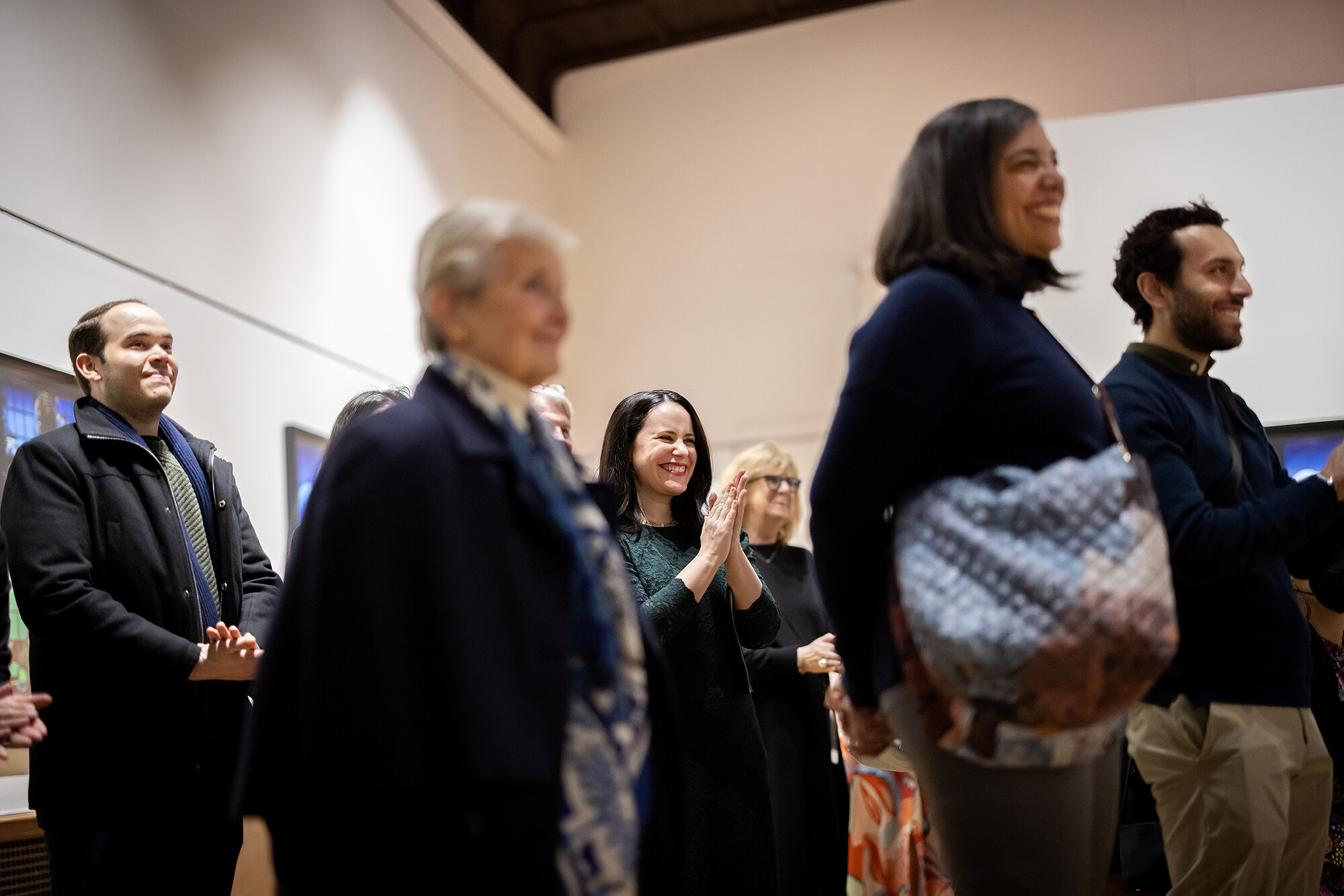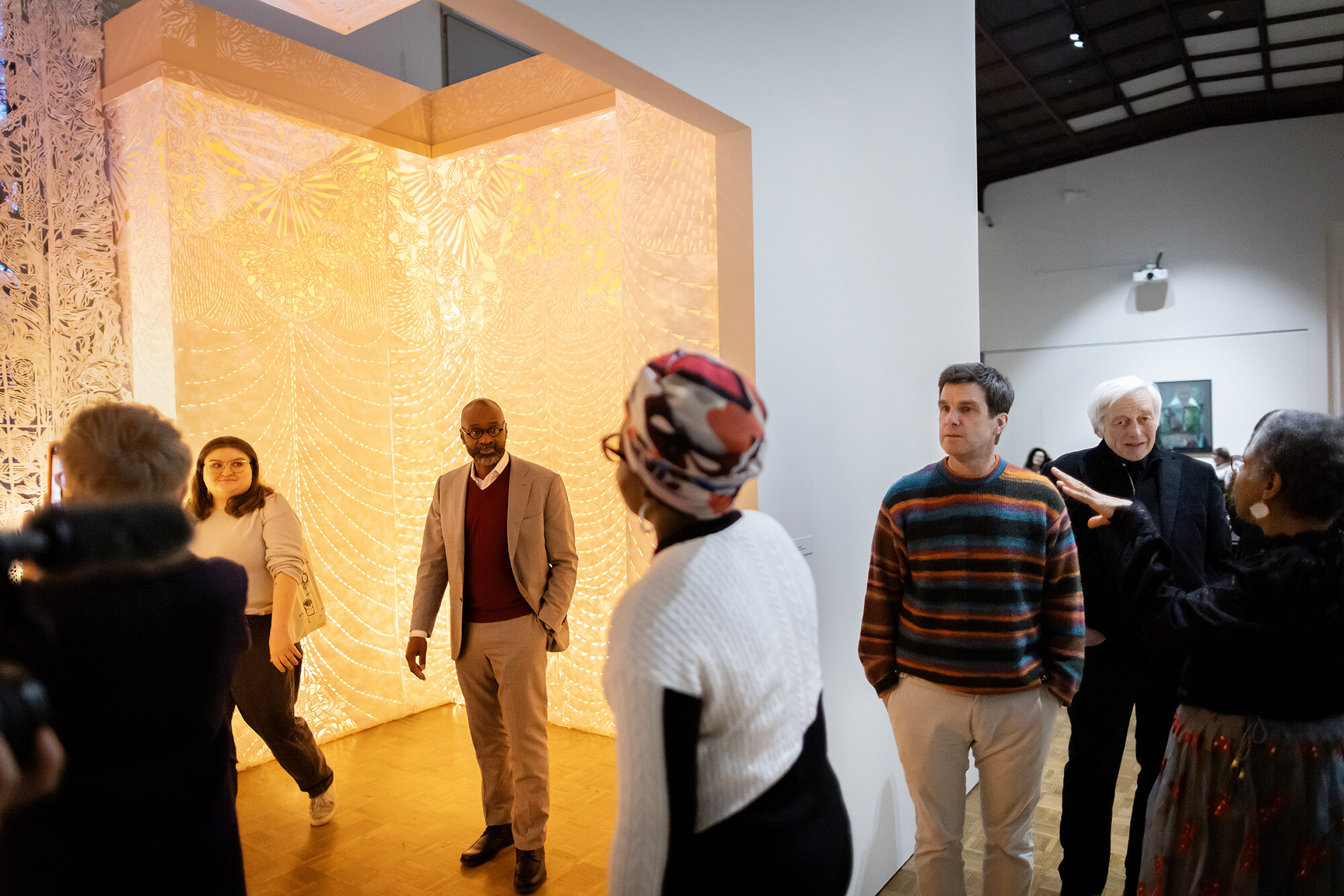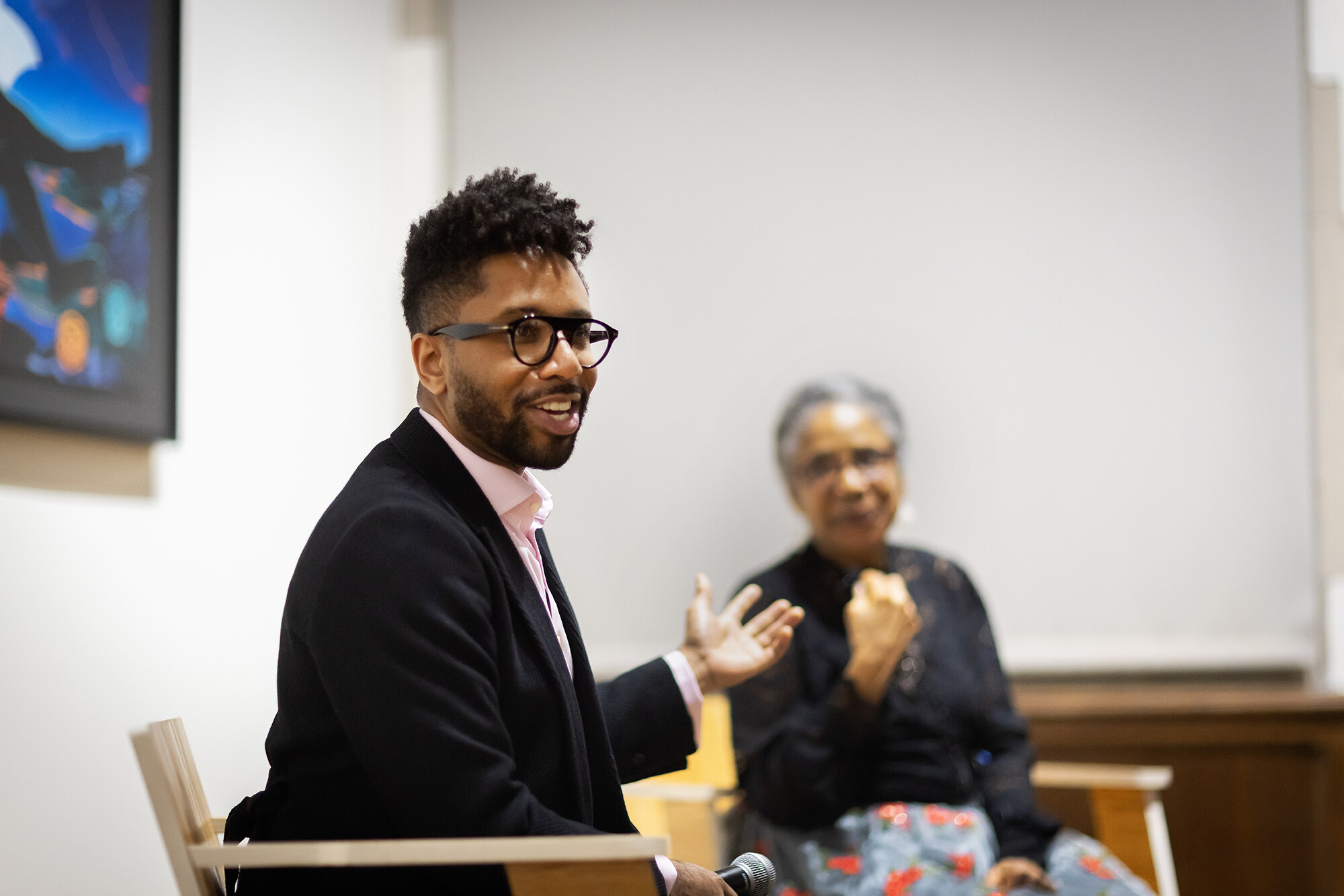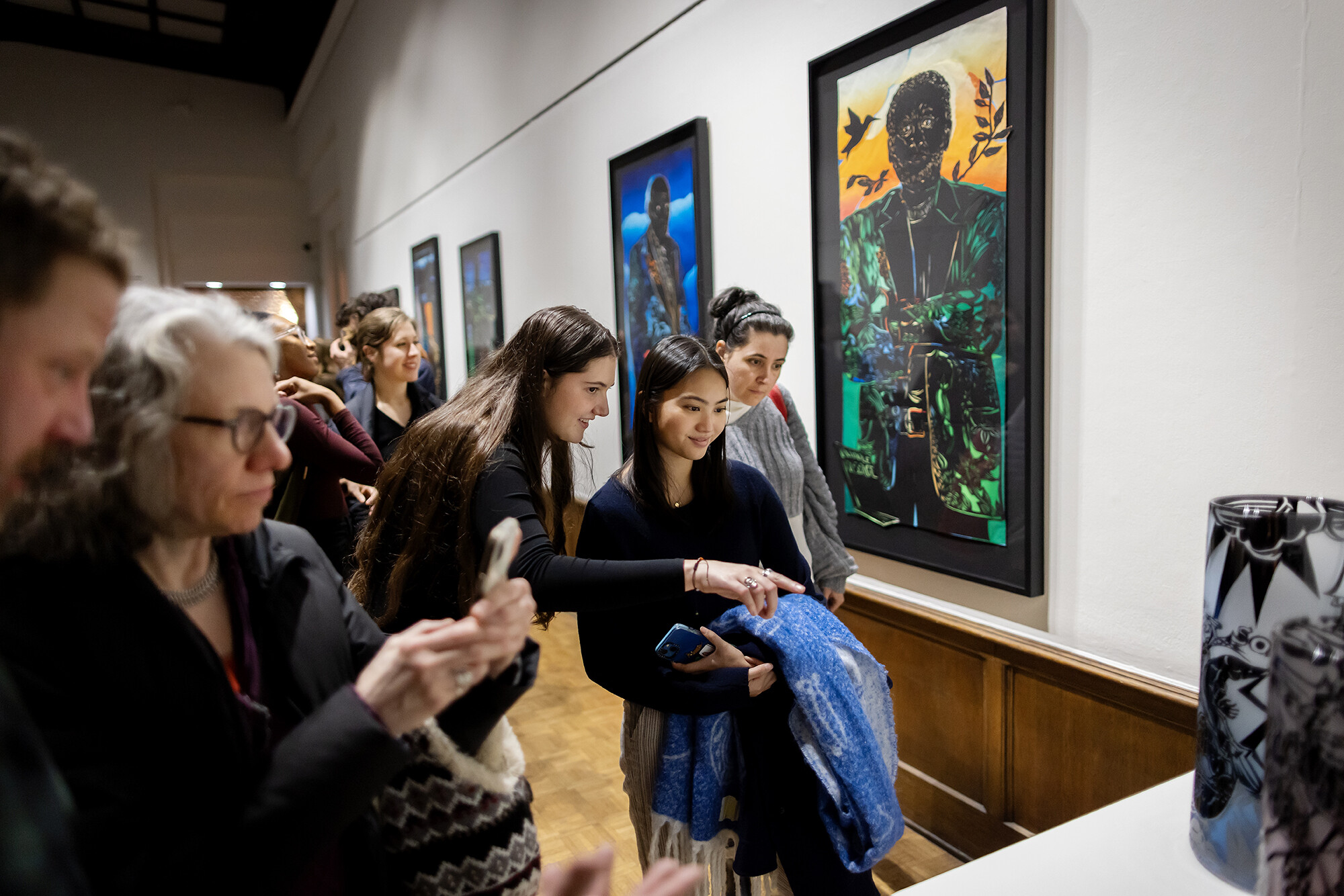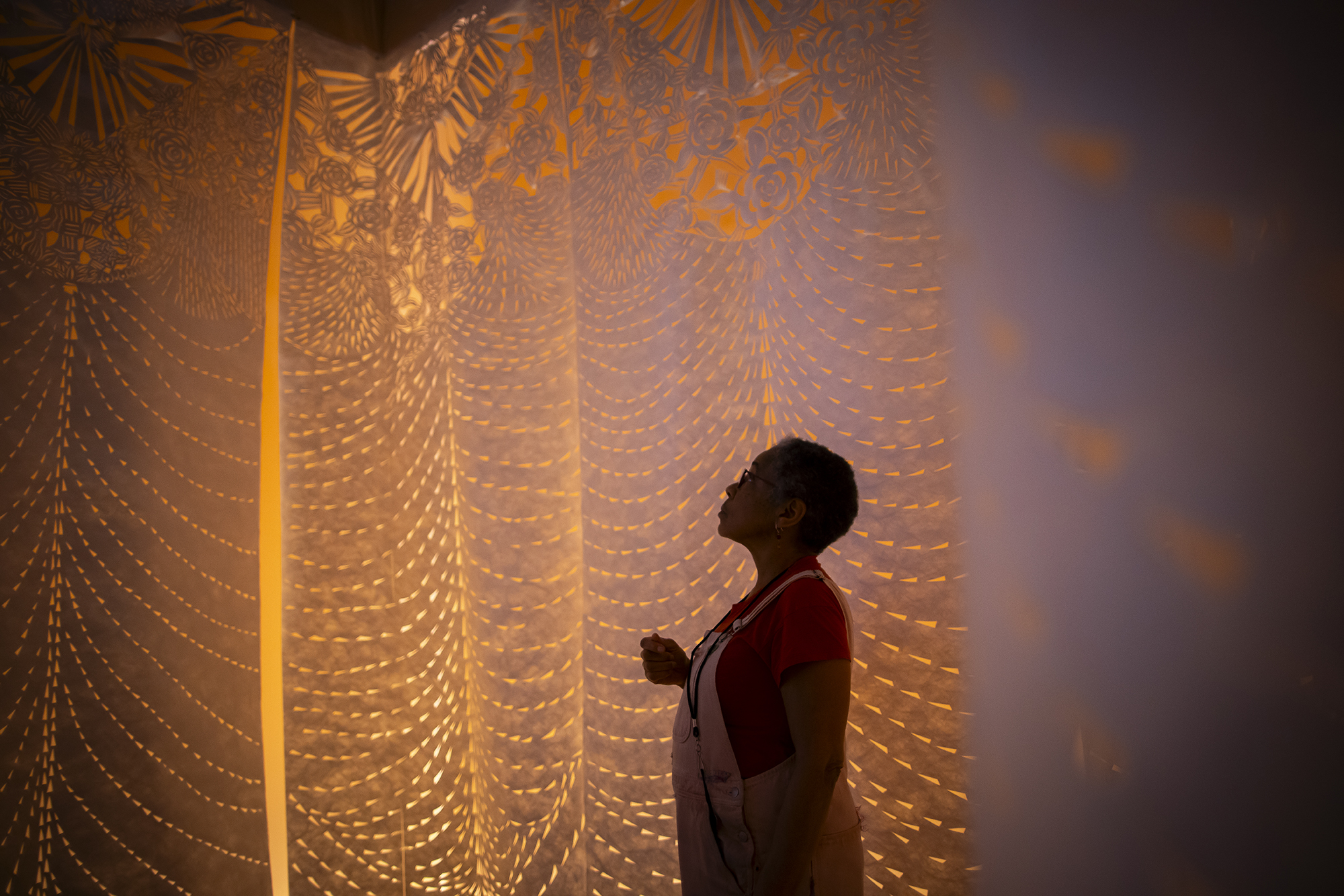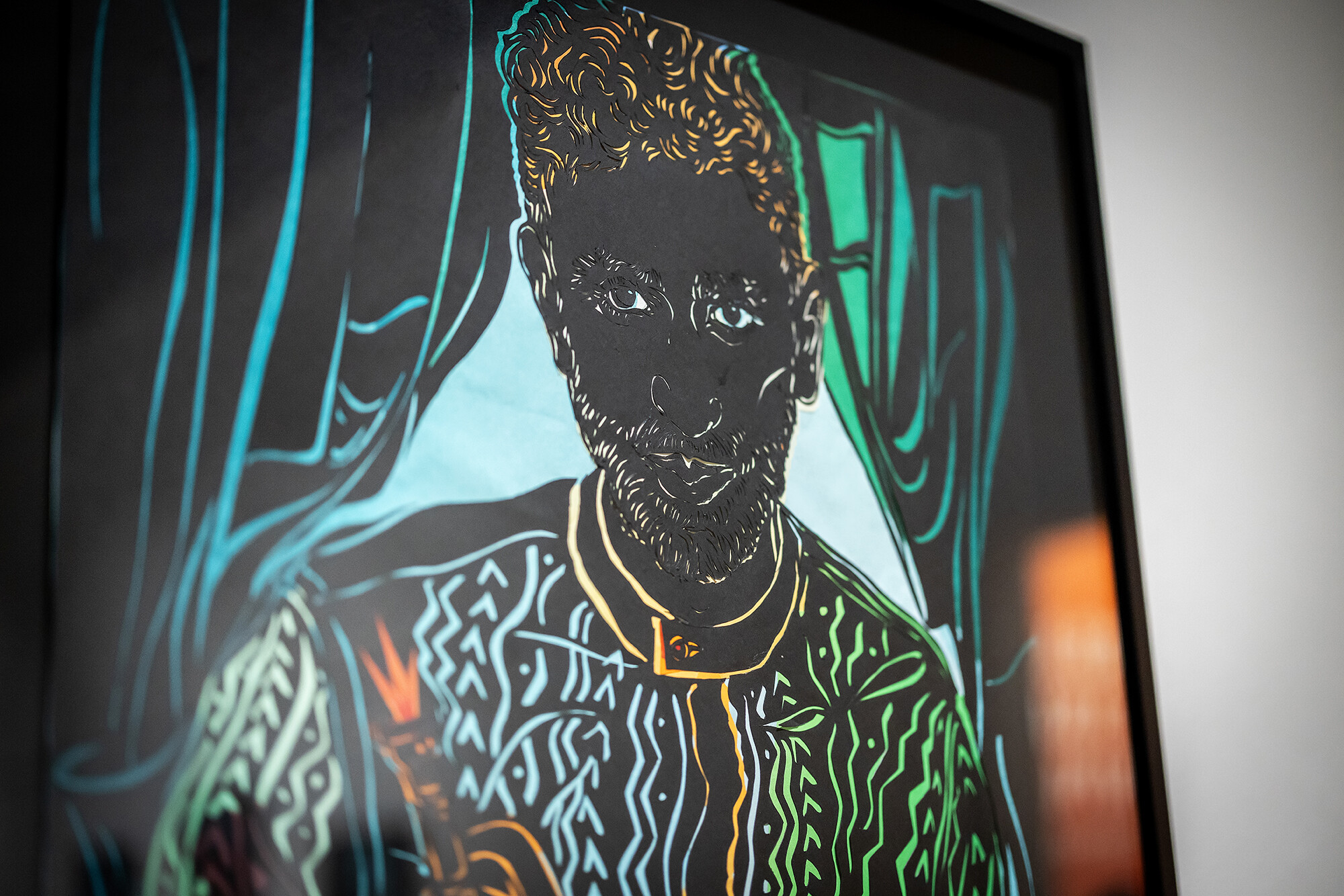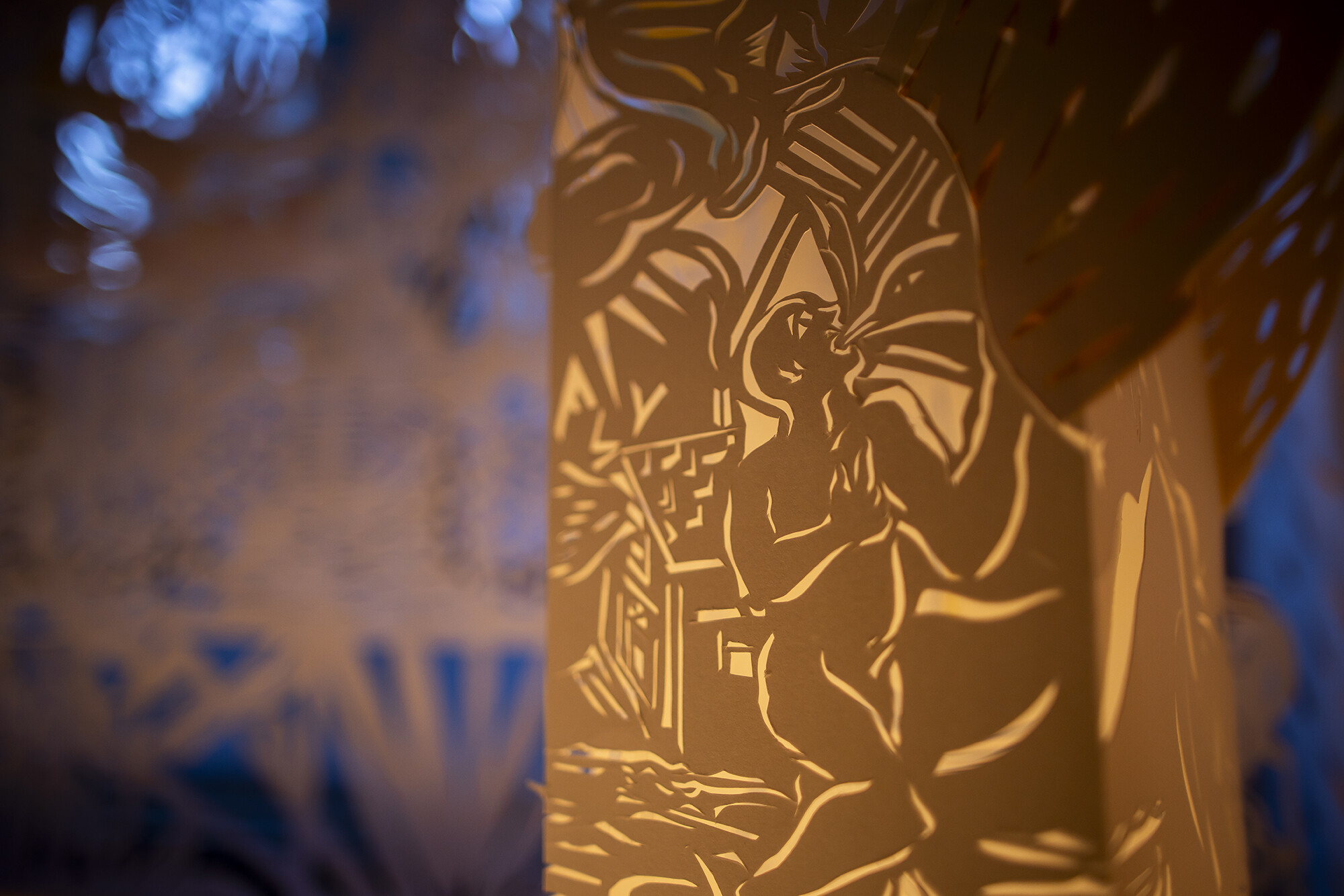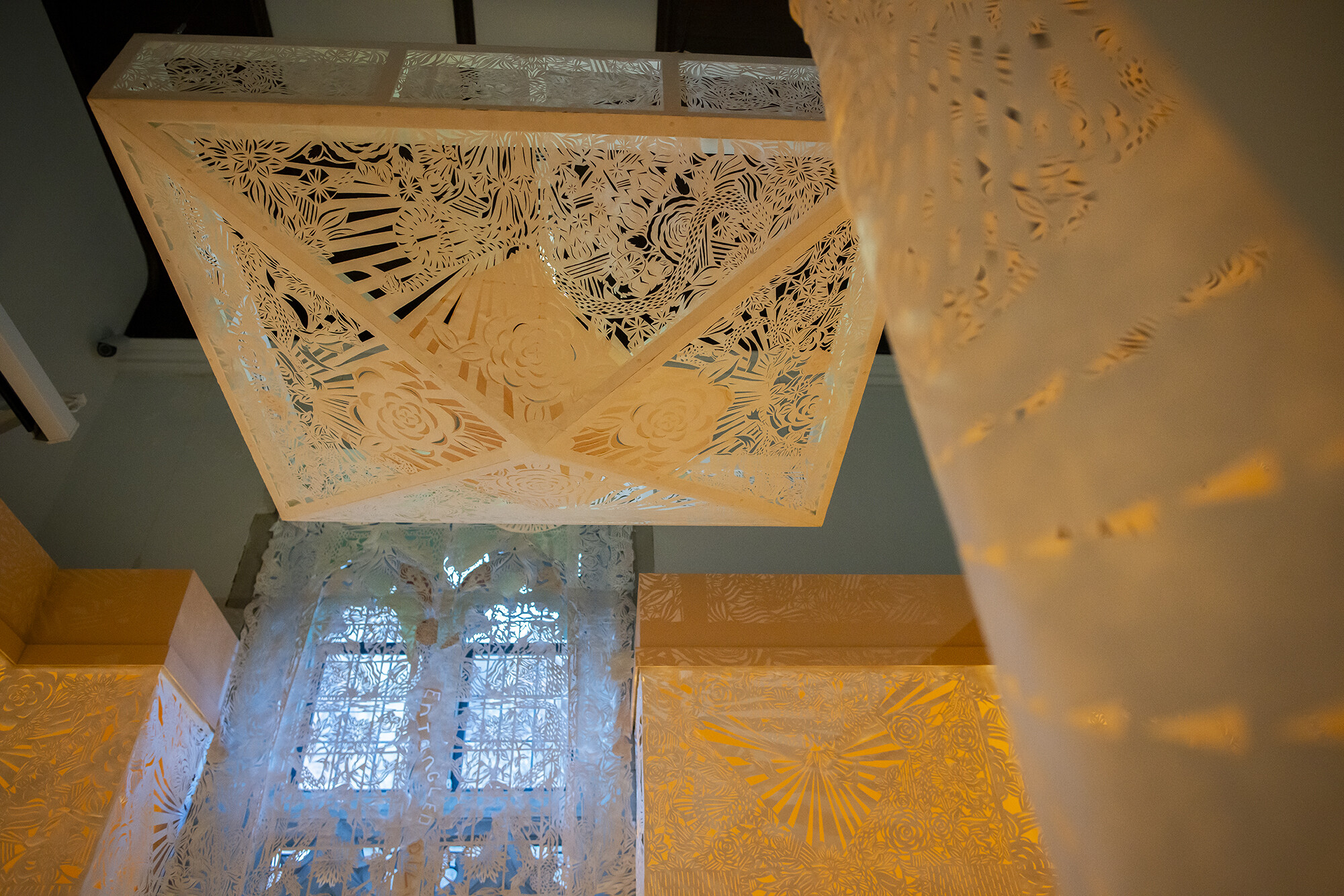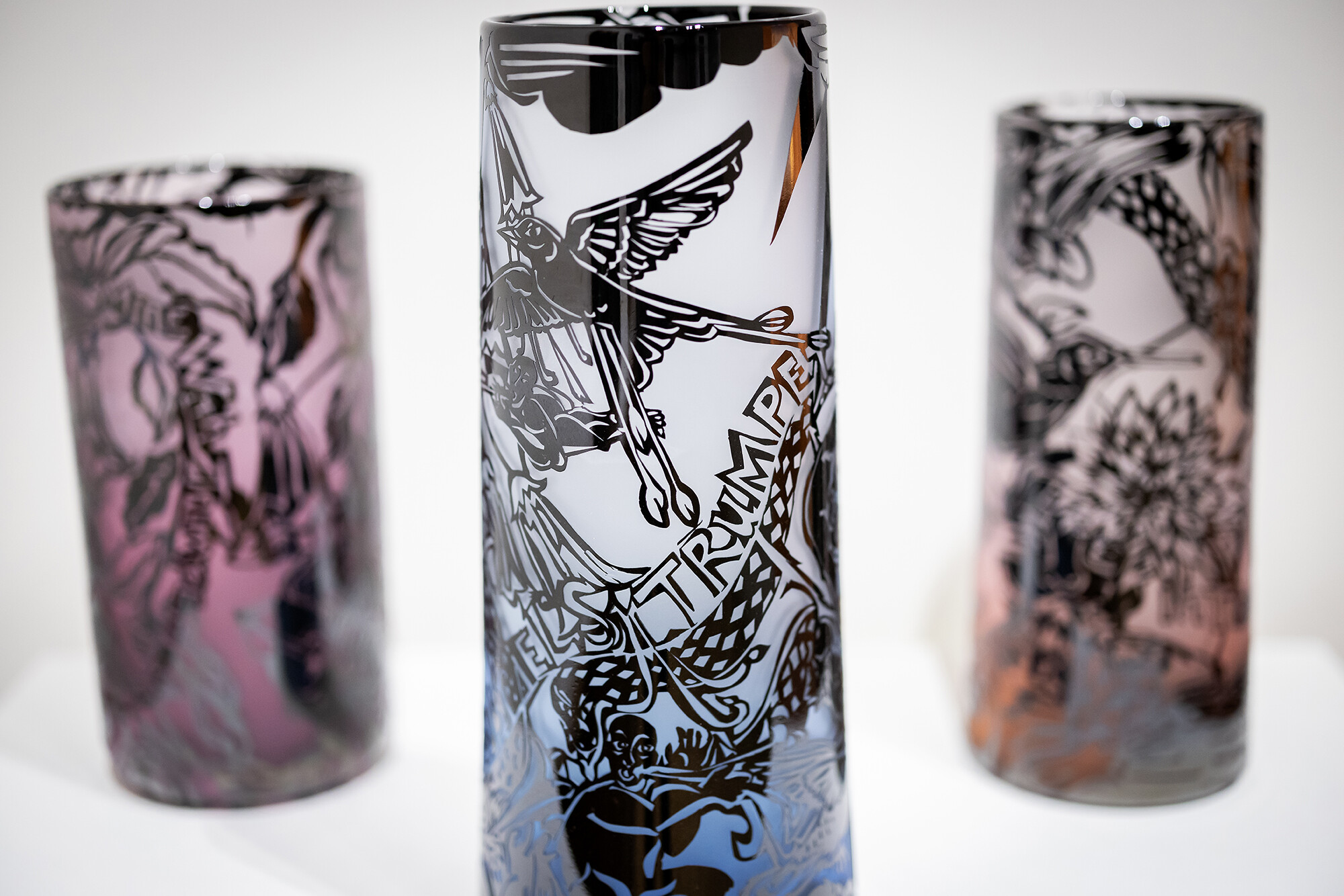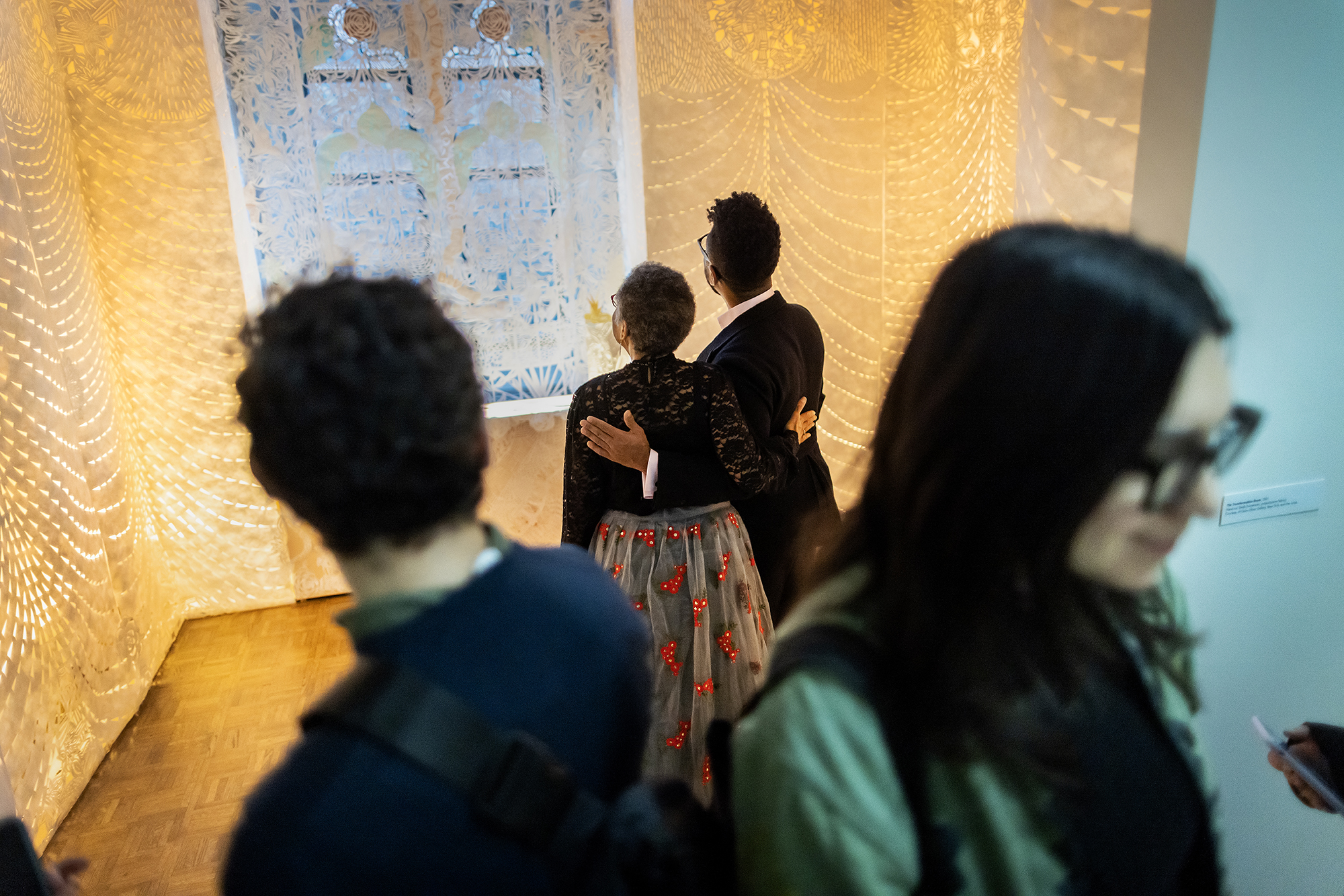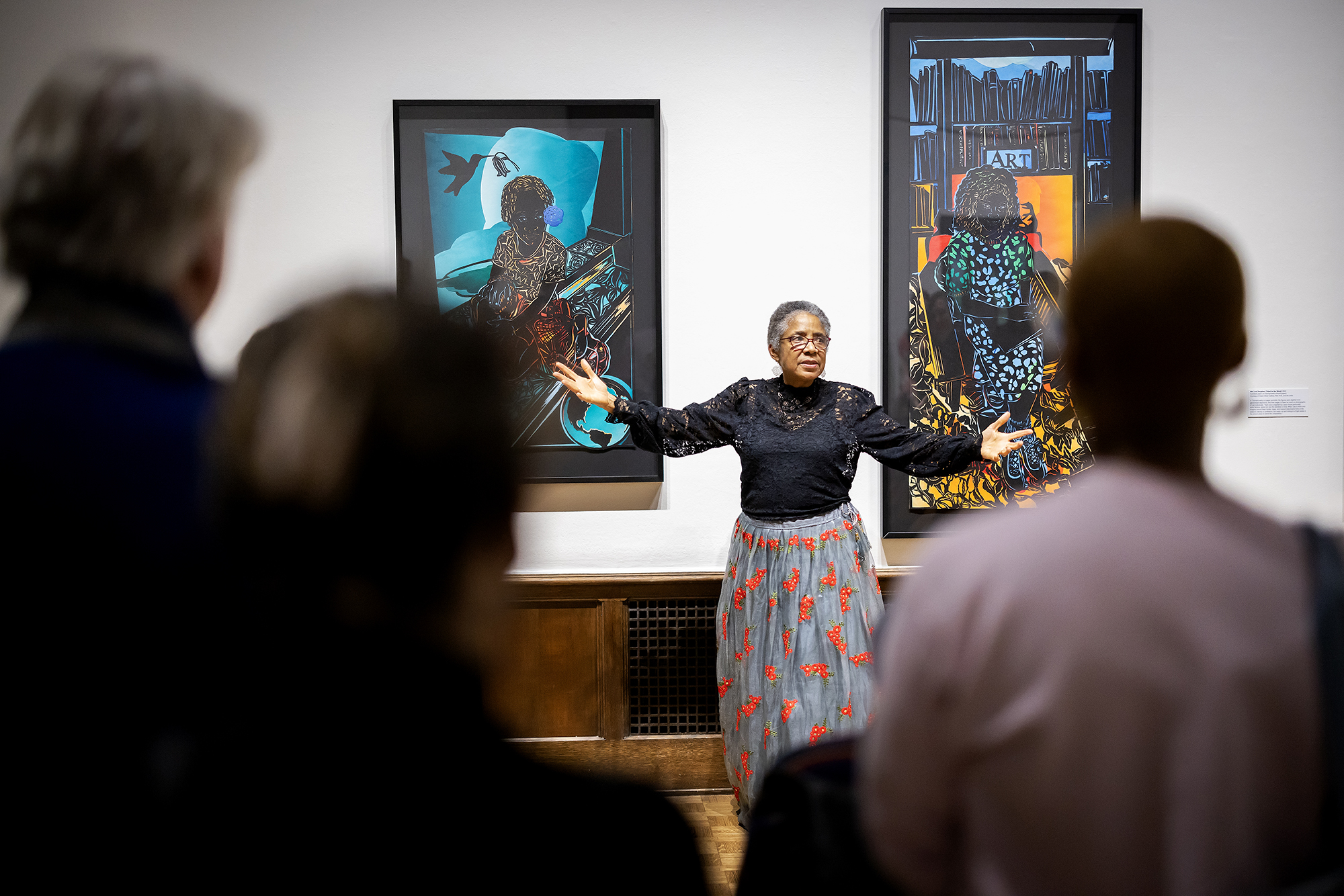
Light streams through thousands of cutouts in intricate patterns on long white Tyvek drapes enveloping a new room-within-a-room in a corner of Penn’s Arthur Ross Gallery. Illumination comes from the window incorporated into the design, and from behind the curtains of material and an ornately decorated fixture overhead.
“The Transformation Room” is part of the exhibition, “Barbara Earl Thomas: The Illuminated Body,” on view through May 21, along with a series of nine large cut-paper portraits and three works of hand-blown glass.
“It’s kind of this jewel-box of an experience,” says Barbara Earl Thomas, who is based in Seattle. “I think it’s all come together just exactly the way it should have.”
Nearly 300 people attended the Feb. 16 exhibition opening, which featured Thomas in conversation with Emily Zimmerman, Arthur Ross Gallery interim director of exhibitions & programs. Also featured was Grammy-nominated cellist Seth Parker Woods, who will be performing a multimedia show, “Difficult Grace,” at Penn Live Arts in April as part of the exhibition programming.
“This exhibition is all about light and awe and joy,” says Zimmerman, who curated “The Illuminated Body” at the Arthur Ross Gallery. A traveling exhibition, it began last February at the Chrysler Museum of Art in Norfolk, Virginia, and then went to the Wichita Museum of Art in Wichita, Kansas, in October. Penn is its third and final stop. For this final iteration of “The Illuminated Body,” Thomas has specifically responded to the Arthur Ross Gallery’s Venetian Gothic architecture and added Woods’ music as part of the experience.
In one of several firsts for the Arthur Ross Gallery, the exhibition is supported by a 2023 project grant awarded by the Pew Center for Arts & Heritage, written by Zimmerman. A day-long community celebration, also supported by Penn’s Sachs Program for Arts Innovation, is being organized by the Gallery’s first community advisory group. And the performance by Woods will be the Gallery’s first high-level collaboration with Penn Live Arts.
Woods’ performance includes Thomas’ artworks, “so you really get a sense of an interwoven creative fabric between the visual arts and the performing arts,” Zimmerman says, noting the Pew grant made it possible for “that full collaborative vision” to be realized.
“I know and love the creative community in Philadelphia and the way that art is very present in the fabric of our city,” Zimmerman says. “So it struck me that this exhibition with its emphasis on multidisciplinary collaboration would be something that would resonate.”
Also it’s the first time Thomas has exhibited in Philadelphia.
“As an artist, Barbara Earl Thomas has been part of the art world for a long time. But as is the case with many artists working on the West Coast, often the East Coast has very little knowledge of what they’re doing, which is why it’s so wonderful to have her art on campus,” says Gwendolyn DuBois Shaw, the Class of 1940 Bicentennial Term Associate Professor in History of Art at Penn.
Zimmerman first saw Thomas’s work in Seattle about eight years ago, just as she started her previous job as director and curator of the Jacob Lawrence Gallery at the University of Washington. She came to the Arthur Ross Gallery in 2022: “On the second day I was asked, what exhibition do you want to curate? And the answer was ‘Barbara Earl Thomas,’ ” Zimmerman says.
Art that ‘celebrates Black identity’
“One of the hallmarks of Barbara Earl Thomas’s work is that she focuses on the Black community in ways that we often don’t see in American art. She celebrates Black identity, Black history, the experiences of creative African Americans in ways that are really reminiscent of religious imagery,” Shaw says. “She uses this beautiful visual language of light, of color, of outline, shape and form, to really elevate and lift up those individuals and bring them into our awareness.”
Subjects include Black cultural icons playwright August Wilson and author R. Charles Johnson, as well as the artist’s friends and family. “My approach to art has always been that it’s how I interact in the world that feeds back into my work,” Thomas says. “My reason for making is about the relationships.”
She knows some of the subjects through their work: the book, the play, the cello, the violin, and she incorporates those clues in the portraits. Others she knows in person, like the man who cuts her hair and his daughter, pictured with imagery representing their travels. But it is not necessary to know the people to appreciate the artworks, Thomas says.
“I’m depending on the people who come into this show to bring their own stories, to find things about themselves in the work so that’s what will extend and define what the work is for them,” she says. “My work depends on that relationship.”
The portraits are created by cutting patterns in black paper and placing that over layers of hand-printed, custom-colored paper, creating a vivid kaleidoscope that shows through. Given her printmaking background with linoleum cut (linocut) and etchings, the paper cutouts made sense. “Sometimes you just have to play to your strengths,” she says.
The works are reminiscent of stained-glass windows, says Shaw, who has been on the advisory committee for windows in the National Cathedral in Washington D.C. A recent commission for Thomas was a stained-glass window installation at Yale University.
“Thomas’ work has really transformed this space in the Arthur Ross Gallery. I’m so used to coming here and seeing different works of art on the walls, but this is the first time I’ve come in and felt like I’m in a kind of sacred space, a holy space, a space of worship,” Shaw says. “It gives a very contemplative aspect, a very reflective aspect.”
Bringing music and art together
Thomas’s portrait of Woods playing a cello, titled “A Joyful Noise,” is the cover of his album “Difficult Grace.” And music from that album plays in the Arthur Ross Gallery during “The Illuminated Body” exhibition.
Both Thomas and Woods call their collaboration “organic,” meeting in Seattle in 2019 and continuing to correspond throughout the pandemic as they worked on their projects.
An assistant professor of practice at the University of Southern California’s Thornton School of Music, Woods was working on the multimedia show “Difficult Grace” that incorporates music, spoken text, visual arts, film, and dance, “sonic and visual storytelling,” he says. “I’ve always called it the semi-autobiographical work of mine that is both pulling on the stories of my own, as well as those of my ancestors.”
Thomas asked if she could make a portrait of Woods and he agreed. In the artwork’s background is her interpretation of the 60-panel “The Migration Series” by artist Jacob Lawrence, one of the 20th century’s most acclaimed visual storytellers of Black American experiences. Thomas studied under Lawrence at University of Washington, and she serves on the board of his foundation.
“I think she’s found a way to kind of bring all these different folks together as a way of honoring the past and all our present futures,” Woods says. He noted the portrait’s detail of layers and depth and mass: “I really feel like there is still actual movement inside of it.”
Thomas helped Woods obtain images of Lawrence to incorporate into “Difficult Grace,” becoming the connector between the two creators. With all of this collaboration “no money has changed hands,” Thomas says. “All that’s changed hands is reciprocal goodwill.”
‘The Transformation Room’
In each of the three locations of “The Illuminated Body” exhibitions, Thomas has customized “The Transformation Room” installation to fit the space. The Arthur Ross Gallery is the only one to include an outside window, letting natural light in through the floral pattern. “It was my way to honor the architecture, my way to honor the history of the building and the space, my way of making it mine, and then sharing it with the people who come in,” Thomas says.
Trained as a painter with experience working with fabric, she started the paper-cut work in 2015. It was natural for her to make the cuts by hand, she says, because growing up “if you wanted something done in your house, you just made it.” Sure, a laser cutter could do the work, but she says “it’s important to me that the hand is still in it as long as I can. Then the work has a vibrancy.”
Approaching the challenge of “The Transformation Room” she found material could she carry by herself, and what project would make it possible for others to help. A dozen friends helped to make the cuts with X-ACTO knives, following her swirling pattern. “We’re all working kind of as one body,” she says. “And you know what? It works out.”
Light is what links the varied elements of “The Transformation Room,” Thomas says. “I hope that when people come in, they’re in there with people they don’t know, and that they'll have a moment of awe,” she says. “Maybe they’ll introduce themselves to each other, maybe two people who are really different in lots of ways will find one thing they have in common, just one. Sometimes that’s the only chance.”
Sharing with Penn and Philadelphia
A number of events are planned and in the works, including Woods’ “Difficult Grace” performance at Penn Live Arts on April 11; and an illustrated lecture on March 26 by Shaw, “Black Girl’s Window: Re-framing Contemporary Reparative Artistic Practices,” that will consider work by African American artists that uses windows; and an artist talk by Marisa Williamson “Lightbox: An Illuminated Lecture,” on April 26, in conjunction with (re)FOCUS 2024, a citywide Philadelphia festival on women in the visual arts.
Shaw says she expects many Penn students will experience the Arthur Ross Gallery exhibition, and the related events, through their classes, including those in her contemporary art course.
“When I assign exhibitions to my students like this one, I hope that they come into the show with their eyes and their minds wide open, and that they think about different ways that we can make art, whether it’s using a paper, a pigment, or glass, or Tyvek. I mean, Tyvek, that’s something that I usually see on the sides of houses that are under construction,” Shaw says.
“So, I hope my students come away thinking that there are many different ways to make art, many different themes, and topics, concerns, that artists can take up and make beautiful things with.”




